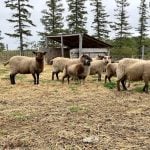A promising cherry cultivar under evaluation at the University of Saskatchewan has potential for prairie growers and might be useful in fighting cancer and heart disease.
The dwarf cherry fruit gaining most approval under the project is the SK Carmine Jewel, a new variety introduced by the university.
It is recommended for the home gardener as a low-suckering genotype and probably will be available in the spring of 1999. It is among the selections still being evaluated for commercial fruit production.
Technician Rick Sawatzky at the department of plant sciences said food scientists at the University of Michigan have found that tart cherries, closely related to the dwarf cherries in the U of S program, contain compounds with antioxidant and anti-inflammatory properties.
Read Also

VIDEO: Agritechnica Day 4: Robots and more robots, Nexat loves Canada and the trouble with tariffs
Agritechnica Day 4: Robots and more robots, Nexat loves Canada and the trouble with tariffs.
This research found cherry growers, who eat six times the amount of cherries as the average American, have a lower incidence of cancer and heart conditions. The research also suggested the most active antioxidant compounds in cherry fruit are superior to vitamins E and C and some synthetic antioxidants.
“It is interesting to note that these superior antioxidants in tart cherries are anthocyanins, which are associated with the bright red color. Our dwarf cherries have a more intense red color than Montmorency, the most commonly grown tart cherry in Michigan. Our dwarf cherry fruit has not been tested for antioxidant concentration, but it is reasonable to expect high levels,” said Sawatzky.
The Saskatoon project is evaluating processing characteristics of various fruits and Sawatzky is hopeful about SK Carmine Jewel, saying it is excellent for juices, syrups and toppings.
“If it hangs on the bush long enough, it’s also good fresh,” he said.
Part of his project involved planting about 9,000 dwarf cherry seeds in the university’s nursery in 1995, and distribution of about 6,000 seedlings to fruit growers throughout the province in 1996.
The wide distribution allows growers in varied locations to gain experience with the plants and provides evaluations of the plants’ adaptability to different climates.
Dwarf cherries aren’t the only small fruits in Sawatzky’s project. Cherry-plum cultivars have also been part of the long-term work and enough information has been collected to make limited recommendations about four varieties: Dura, Manor, Gamma and Omega.
“These four cultivars, which were propagated more than five years ago, seem to be the hardiest of those with promising fruit quality. More work needs to be done on pollinizer requirements, but they have the best quality for processing,” he said.
Selections of black currents, filberts and wild plums have also been distributed to growers, but Sawatzky said it’s too early to make recommendations.
Sawatzky and Karen Tanino, an associate professor in the university’s department of plant sciences, have received financing from the Saskatchewan Agriculture Development Fund to continue work on domestic fruit development.














